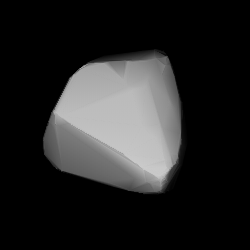941 Murray is a background asteroid, approximately 18 kilometers in diameter, located in the central region of the asteroid belt. It was discovered by Austrian astronomer Johann Palisa at the Vienna Observatory on 10 October 1920. The X-type asteroid has a short rotation period of 3.4 hours. It was named after British professor Gilbert Murray (1866–1957).
1994 Shane, provisional designation 1961 TE, is a dark Adeonian asteroid from the central region of the asteroid belt, approximately 25 kilometers in diameter.
2348 Michkovitch, provisional designation 1939 AA, is a presumed carbonaceous Erigone asteroid from the inner regions of the asteroid belt, approximately 15 kilometers in diameter. It was discovered by Serbian astronomer Milorad Protić at Belgrade Observatory on 10 January 1939. The asteroid was named after Serbian astronomer Vojislav Mišković.
5318 Dientzenhofer, provisional designation 1985 HG1, is a stony background asteroid from the inner regions of the asteroid belt, approximately 6 kilometers (3.7 miles) in diameter. It was discovered on 21 April 1985, by Czech astronomer Antonín Mrkos at the Kleť Observatory in Bohemia, Czech Republic. The transitional S-type asteroid has a rotation period of 8.06 hours. It was named after the German Baroque architects Christoph and Kilian Ignaz Dientzenhofer.
6377 Cagney, provisional designation 1987 ML1, is a carbonaceous Eunomia asteroid from the central region of the asteroid belt, approximately 9 kilometers in diameter.

9983 Rickfienberg is a carbonaceous asteroid from the middle region of the asteroid belt, approximately 10 kilometers in diameter. It was discovered on 19 February 1995, by American astronomer Dennis di Cicco at his private Sudbury Observatory, Massachusetts, United States. It was named after American astronomer and editor Richard Fienberg.
3192 A'Hearn, provisional designation 1982 BY1, is a carbonaceous asteroid from the inner regions of the asteroid belt, about 6 kilometers in diameter. It was discovered by American astronomer Edward Bowell at Lowell's Anderson Mesa Station in Flagstaff, Arizona, on 30 January 1982.
2572 Annschnell, provisional designation 1950 DL, is a background asteroid from the inner regions of the asteroid belt, approximately 10 kilometers in diameter.
1543 Bourgeois, provisional designation 1941 SJ, is a stony asteroid from the central asteroid belt's background population, approximately 12 kilometers in diameter. It was discovered on 21 September 1941, by astronomer Eugène Delporte at the Royal Observatory of Belgium in Uccle. The asteroid was named after Belgian astronomer Paul Bourgeois.
24101 Cassini, provisional designation 1999 VA9, is an eccentric background asteroid from the middle region of the asteroid belt, approximately 7 kilometers in diameter. It was discovered on 9 November 1999, by American amateur astronomer Charles Juels at the Fountain Hills Observatory (678) in Arizona, United States. It was named after Italian–French astronomer Giovanni Cassini.

1555 Dejan, provisional designation 1941 SA, is an asteroid from the background population of the central regions of the asteroid belt, approximately 22 kilometers in diameter. It was discovered on 15 September 1941, by Belgian astronomer Fernand Rigaux at the Royal Observatory of Belgium in Uccle. The asteroid was named after Dejan Đurković, son of Serbian astronomer Petar Đurković.
1184 Gaea, provisional designation 1926 RE, is an Aerian asteroid from the central regions of the asteroid belt, approximately 20 kilometers in diameter. It was discovered on 5 September 1926, by astronomer Karl Reinmuth at the Heidelberg-Königstuhl State Observatory in southwest Germany. The asteroid was named after the goddess of Earth, Gaea (Gaia), from Greek mythology.
3099 Hergenrother, provisional designation 1940 GF, is an asteroid from the outer region of the asteroid belt, approximately 15 kilometers in diameter. It was discovered on 3 April 1940, by Finnish astronomer Yrjö Väisälä at Turku Observatory in Southwest Finland, and named after American astronomer Carl Hergenrother in 1996.
1412 Lagrula, provisional designation 1937 BA, is an asteroid from the inner regions of the asteroid belt, approximately 7 or 23 kilometers in diameter, depending on the body's divergent reflectivity measurements.

1361 Leuschneria, provisional designation 1935 QA, is a carbonaceous asteroid from the outer regions of the asteroid belt, approximately 30 kilometers in diameter. It was discovered on 30 August 1935, by Belgian astronomer Eugène Delporte at Uccle Observatory in Belgium, and named after American astronomer Armin Otto Leuschner.
1235 Schorria, is a Hungaria asteroid, sizable Mars-crosser, and exceptionally slow rotator from the inner region of the asteroid belt. The carbonaceous C-type asteroid has an outstandingly long rotation period of 1265 hours and measures approximately 5.5 kilometers kilometers in diameter. It was discovered by Karl Reinmuth at Heidelberg Observatory in southwest Germany on 18 October 1931, and named after German astronomer Richard Schorr (1867–1951).
1511 Daléra, provisional designation 1939 FB, is an asteroid from the inner regions of the asteroid belt, approximately 12 kilometers in diameter. It was discovered on 22 March 1939, by French astronomer Louis Boyer at the Algerian Algiers Observatory, North Africa, and named after Paul Daléra, a friend of the discoverer.
2613 Plzeň, provisional designation 1979 QE, is an asteroid from the outer region of the asteroid belt, approximately 28 kilometers in diameter. It was discovered on 30 August 1979, by Czech astronomer Ladislav Brožek at the South Bohemian Kleť Observatory in the Czech Republic. It was later named for the Czech city of Plzeň.
12999 Toruń, provisional designation 1981 QJ2, is a carbonaceous Baptistina asteroid from the inner regions of the asteroid belt, approximately 8 kilometers in diameter. It was discovered on 30 August 1981, by British–American astronomer Edward Bowell at Lowell Observatory's Anderson Mesa Station in Flagstaff, Arizona, and named after the Polish city of Toruń.
(457175) 2008 GO98, provisional designation 2008 GO98 with cometary number 362P, is a Jupiter family comet in a quasi-Hilda orbit within the outermost regions of the asteroid belt. It was discovered on 8 April 2008, by astronomers of the Spacewatch program at Kitt Peak National Observatory near Tucson, Arizona, in the United States. This presumably carbonaceous body has a diameter of approximately 15 kilometers (9 miles) and rotation period of 10.7 hours.



